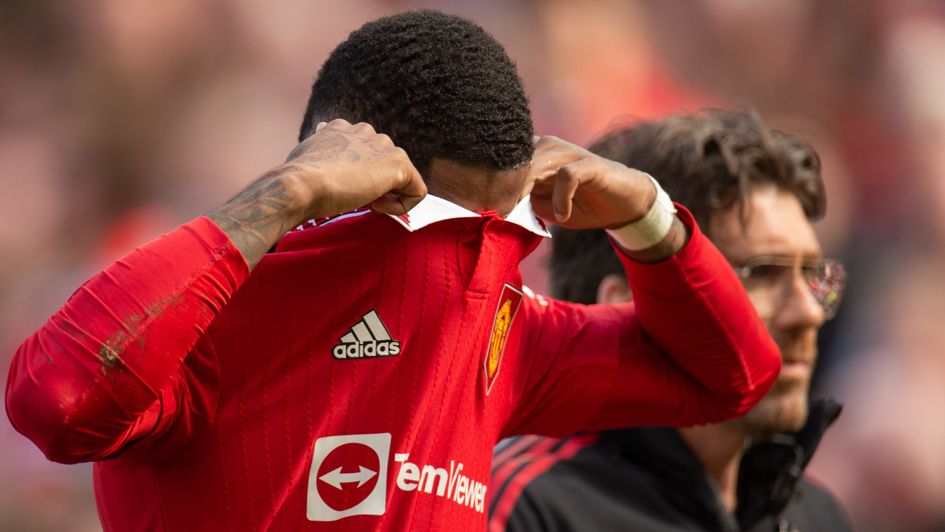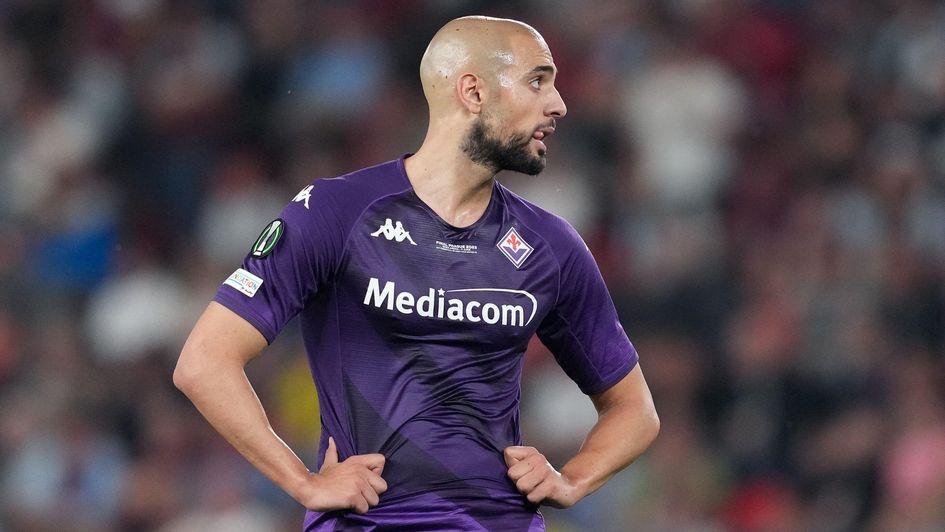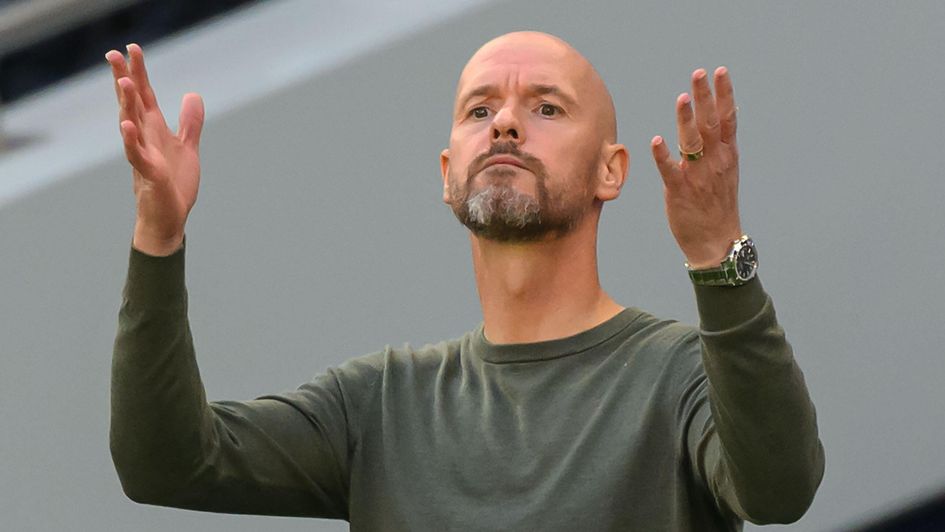- Re-published after defeats by Palace and Galatasaray
Brighton have the ball on the left flank, a pass finds Danny Welbeck in space, who cuts it back into the Manchester United penalty area to hit the feet of Pascal Gross - he makes no mistake in converting. It is August 2022.
No wonder there was a feeling of deja vu for Erik ten Hag when Brighton emerged 3-1 victors at Old Trafford in September.
Added to poor showings in defeats by Arsenal and Tottenham it meant they had just six points after five games, the first time in the Premier League era United had lost three of the first five.
Things got worse as they failed to ever really test Bayern in defeat in the Champions League despite the flattering 4-3 scoreline.
They bounced back at Burnley but fell to a 1-0 defeat to Crystal Palace at Old Trafford on Saturday.
So after a first season that was deemed a success, why has the start to the second been just so bad?
More to the point, are things as bad as they look or can they turn it around after back to back home defeats?
Depleted defence

Being without key defenders Luke Shaw and Raphael Varane has caused major issues.
But further injuries to Tyrell Malacia and Aaron Wan-Bissaka is what has left Ten Hag's squad razor thin.
And we're only just getting started with the problems.
Imbalanced midfield

One immediately noticeable factor in United's poor start is the midfield configuration.
Last season, Casemiro was partnered with Christian Eriksen, a partnership which produced encouraging results before an injury to the Dane derailed momentum.
This term, Ten Hag has shifted into more of a 4-3-3 shape with Casemiro at the base of midfield behind two advanced number 8 type midfielders, typically Bruno Fernandes and Mason Mount.

In their opening game against Wolves, which they were very fortunate to win, Casemiro was consistently left isolated.
It meant United were far too easy to play through, especially in defensive transition where Casemiro had too much ground to cover alone.
With their boss looking to be more aggressive on and off the ball, the Brazilian's age is starting to show.
And the ability to work on how this new midfield trio may function has been hampered by Mount's current injury absence.
Striker shortage

Before Rasmus Hojlund's long-awaited full debut against Brighton, the absence of a number 9 had caused Marcus Rashford to often be United's only viable offensive outlet.
Ten Hag first deployed him up front before then bringing the sidelined Anthony Martial back into the fold, to little positive consequence.

Only when Hojlund came on against Arsenal did United see the benefits of having a real number 9 profile up front.
Without wingers
Although United may now be able to move Rashford back to his strongest position on the left, they are currently without Antony and Jadon Sancho for very different, well-documented reasons.
Their absence has had huge knock-on effects far beyond individual output, with Ten Hag opting to try and play with a midfield diamond against Brighton.

That only exacerbated something that has been alarming so far this season: United's shape has been all over the place.
They also seem unable to maintain intensity even if they start games well. This was the case against Tottenham and Brighton.
Both Ange Postecoglou and Roberto de Zerbi were able to work out tactical tweaks in build-up to play through United's aggressive high-press, making them easy to play through once the first line of the press is beaten.

Ten Hag's diamond - with Bruno Fernandes at the tip behind Rashford and Hojlund - against Brighton did not work.
He is less likely to repeat this as the season goes on when the ideal options in wide areas return.
'Too easy to play against'
All this dysfunction in the United team has led to one stark reality: they are far too easy to play against.

Only four Premier League teams have conceded more open-play shots (56) and only two have allowed more expected goals (xG) (8.07).
These are alarming numbers for a side with aspirations of European qualification and silverware this season.
Can Ten Hag fix it fast?
Ten Hag has shown enough in his time so far at United to think he will find a fast solution - as he did at home to Liverpool 13 months ago.
The upcoming run of games presents a perfect opportunity for him to do so, with Crystal Palace, Sheffield United, Burnley and Brentford the next four opponents.
And while it may seem like it, it's not all doom and gloom.
Hojlund could be huge

Getting Hojlund match fit will be key.
The Dane has been a bright spark in his appearances thus far, first with a cameo against Arsenal and then starting against Brighton, where he was a handful for the Seagulls defence with his movement in the box and intelligent pressing when United were on top of things early on.

Ten Hag will hope this gets Rashford firing on all cylinders again too.
With just one goal in five games so far, it has been a frustrating period for the England forward who scored 30 goals in all competitions last term.
Rashford's npxG/shot (non-penalty expected goals per shot) - which is a proxy for shot quality - was 0.15. That was a result of United being able to find him in the right spaces time and again.

This season, that figure has fallen down to 0.09. Although Rashford is seeing a lot more of the ball so far, it isn't necessarily to his benefit.
He did much of his best work alongside a proper number nine last season, so will naturally be delighted to have Hojlund around.
As for the Dane himself, an easier set of fixtures including Burnley, Crystal Palace, Brentford and Sheffield United will be handy for settling into Premier League rhythm before facing Manchester City at the end of October.
Remember Amrabat?
Mason Mount's return from injury should ease matters for United but even more crucial could be a man who you'd be forgiven for forgetting was even a United player.
Sofyan Amrabat is yet to make his debut after joining on loan from Fiorentina. His integration into the side will be crucial.
The Moroccan should be a great complement to Casemiro and ease some of the troubles he has been having in shielding the backline.

United have managed the most high turnovers (59) in the league, an impressive achievement when you consider the level of opponents they have faced.
But none of those turnovers have led to goals, and that is the crucial bit - if United intend to persist with this aggressive approach, then they must get better at executing it.
Only Nottingham Forest and West Ham have a quicker attack in terms of direct speed than United, whose 1.96 m/s makes them one of the most dangerous sides in the league in transition.

At the start of the season, Ten Hag spoke about his intentions to make United the best transition side in the league, and you can see the signs of that in the underlying figures.
Especially with how they are looking to dominate games not just through possession of the ball, but overwhelming teams with their aggression across all phases and exploiting the transitional strengths of their attackers.
It isn't squeaky bum time just yet for Ten Hag but if he fails to show that he can fix things on the pitch, all the support he has garnered thus far will start to dissolve.
More from Sporting Life
Safer gambling
We are committed in our support of safer gambling. Recommended bets are advised to over-18s and we strongly encourage readers to wager only what they can afford to lose.
If you are concerned about your gambling, please call the National Gambling Helpline / GamCare on 0808 8020 133.
Further support and information can be found at begambleaware.org and gamblingtherapy.org.










